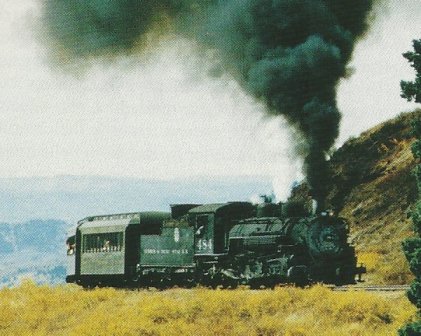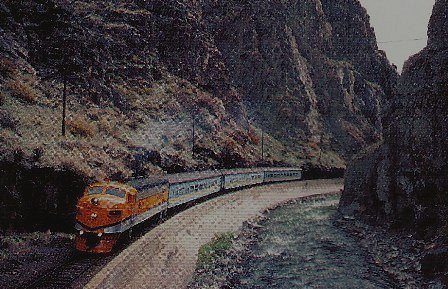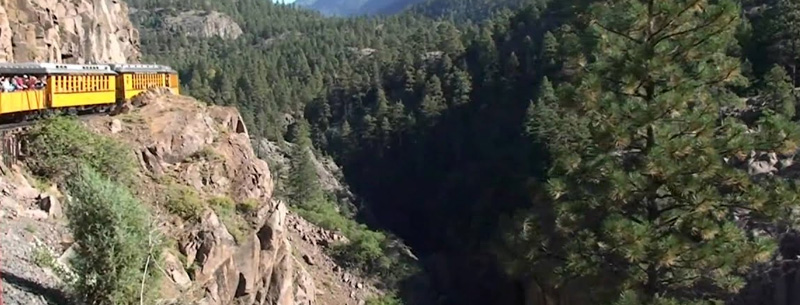Colorado Scenic Railroads began with the popular Pikes Peak Cog Railway, which you can read about on this site. It was a quick and comfortable way to get from the foot of the Peak to the summit. There are other railroads that fall into the category of scenic railroads. In the late 1800s, these railroads were in use traveling all over the mountains of Colorado.
After the turn of the century, many were put out of commission, and the tracks were torn up. With the interest in Colorado history, a few of these rail lines have been brought back to life, taking tourists into the Colorado Rockies and back in time.
Durango Silverton Narrow Gauge Railroad
Originally completed by the Denver Rio Grande Railroad in 1882, the Durango Silverton was the mining train of the gold and silver booms. There were three rail lines coming out of Silverton. All of these tracks were narrow gauge, for travel in the mountains. Durango was known for many years as the “Narrow Gauge Railroad Capital” because at least four tracks ran out of the town.

After the mines played out, very few trains traveled the rail line and it started to fall into disrepair. However, in the 1940s tourists became interested in the 45-mile scenic journey from Durango to Silverton, and business started to pick up. Today, this popular scenic railroad travels the same path as the original route.
Visitors can have the same experience traveling through the Animas Canyon as those a century ago did. The train has added open-air and private cars and also a lounge car for the comfort of guests. The Durango Silverton runs four trains from May through October. For more information, please visit the Durango Train website.
Cumbres & Toltec Scenic Railroad
This Colorado scenic railroad is also a product of the Denver Rio Grande Railroad that operated in the 1800s between Alamosa and Durango. During the San Juan mountains gold rush days, the Denver Rio Grande was racing to lay track over the Cumbres Pass and on to Durango. The Cumbres & Toltec not only hauled freight and ore but carried passengers to Durango.

When the highway system starting building roads in Colorado, train travel became almost non-existent. However, those with insight realized the need for scenic railroads, and the Cumbres & Toltec was brought back to life.
Historic interest fueled the need for guests to ride the rails and learn about the great ore finds in Colorado and grab a little peek at the history of the state. During the autumn, the mountain scenery is breathtaking. The golden leaves of the aspen trees and snow-covered mountains are dazzling. The Cumbres and Toltec run daily from mid-May through mid-October, weather permitting. Visit the Cumbres and Toltec website for more information and schedules.
Royal Gorge Train Route
This Denver Rio Grande rail line owned by the Union Pacific had been abandoned for many years. However, in 1998, the Union Pacific sold the line to the Canon City & Royal Gorge Railroad. This route is 24 miles through the canyon of the Royal Gorge. The trip takes about two hours.

Some of the sights seen as guests travel along the tracks is the “Hanging Bridge” above the 1,000-foot deep canyon, big horned sheep and stone ruins of the Royal Gorge War. The train runs year-round, daily during the summer, weekends all other times of the year.
The Royal Gorge Train website can give you schedules and times of departure. These are just a few of the popular Colorado Scenic Railroads we, and visitors to the state, have ridden on and really enjoyed. You can find direct links to the railroad tours through the Colorado Resources section of this site. All train tours are narrated throughout your journey, and you will get a rare glimpse into the remains of old gold mines, failed towns, and a great deal of old west Colorado history.
Colorado Railroads Increased the Population of the State
In June of 1870, the line was finished. A silver spike, from the Lebanon mine in Georgetown, was laid at the intersection of the two railroads, and a new era of Colorado history began. Within five years, Colorado’s population tripled and a second railroad ran its line into the state. This was the Kansas and Pacific. Eastern railroad owners finally realized the importance of the state of Colorado to westward expansion.
In the fall of 1870, another railroad laid its line, the Denver Rio Grande. The Denver and Rio Grande was a narrow-gauge line, perfect for traveling the mountains and canyons of the Rocky Mountains.
Two big competitors, the Santa Fe and Denver Rio Grande waged a war between each other to run a rail line to Leadville and the silver mines.
Soon there were railheads all over the eastern foothills of Colorado. The Colorado Midland Railroad was built out of Colorado Springs and headed up Ute Pass and on to the silver mines of Aspen, Leadville, and eventually to the gold mines of Cripple Creek.
Heading into southwestern Colorado and the mines were the Rio Grande Southern Railroad. Its tracks followed the early toll roads traveled by stagecoaches. Soon the entire state was crossed with many different railroad lines, all leading to the Pacific.
The Colorado Railroad map shows all the railroads throughout the state. Some narrow gauge lines are still in use via Colorado Scenic Railroads into the mountains.
Not only did railroads increase the revenue of the state but paved the way further west. Some of the rail lines and trains are still functioning and running today all over Colorado.
Final Word
Colorado railroads were born out of necessity. It was an easy way to transport gold from the goldfields and bring commerce, settlers, and tourists into the territory.
However, it wasn’t until 1853 when the U.S. government sent an expedition into Kansas and westward into the Colorado Territory to survey for a transcontinental railroad. Unfortunately, when these surveys were brought back to D.C., they were ignored and the idea of a railroad into Colorado had died.
Along came the gold rush. For years miners, assayers, and mine owners were looking for a quick way to send their gold for smelting and back east to the mints. Some interest was renewed by the surveys of the 1850s. The Union Pacific, for instance, would run a rail line from Kansas that would clip the northeast corner of Colorado and continue up into Wyoming.
With this news, Denver residents and other Coloradans moved into Wyoming to be near the railroad lines. This was looking like the end of the Colorado Territory ever making it big with the U.S. government. The remaining citizens of Denver decided to fight back and formed a Board of Trade and built their own railroad named the Denver Pacific, which would meet up with the Union Pacific in Cheyenne, Wyoming.
